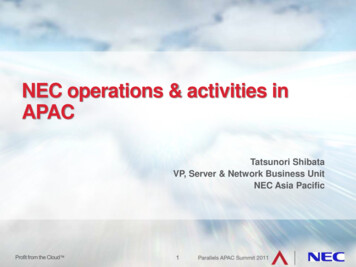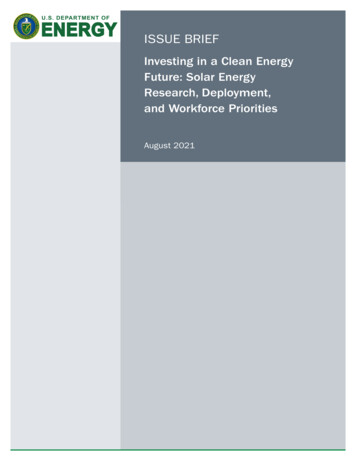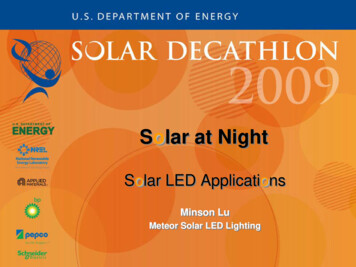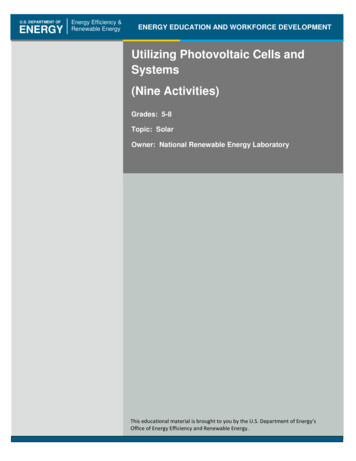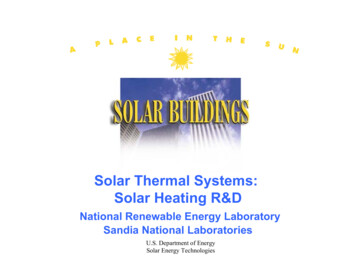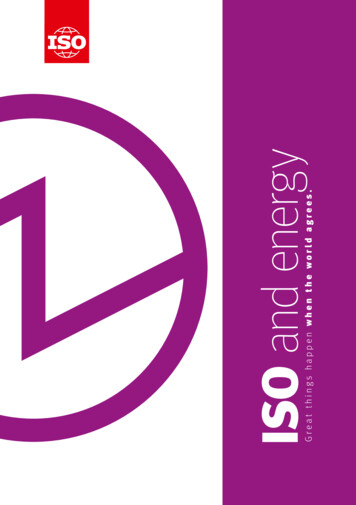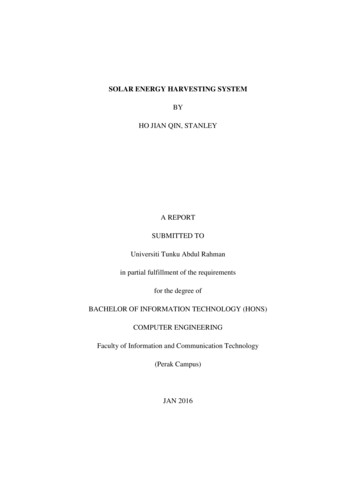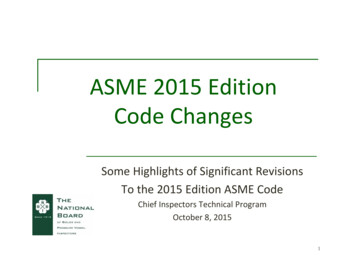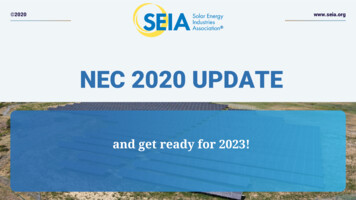
Transcription
2020www.seia.orgNEC 2020 UPDATEand get ready for 2023! 2020www.seia.org
WelcomeInformation provided herein is not considered an official interpretation of the codes and standardsdiscussed. Solar Energy Industries Association and the respective presenters, unless otherwise specified.Do not distribute external to the registered attendee’s organization without permission from SEIA. 2020Junewww.seia.org23, 2020www.seia.org2
PresentersKen Boyce UL LLCChair, SEIA C&S WGChair, NFPA 70CMP1Jason FisherSolarTech Consulting Vice Chair, SEIA C&SWG NFPA 70 CMP4Ward BowerWard Bower Innovations Vice Chair, SEIA C&SWG NFPA 70 CMP4 2020www.seia.org3
NEC 2020 Published September 2019 Excellent article on changesimpacting PV 10/pv-installations-for-the-2020nec/ 2020www.seia.org4
NEC 2020 Original SEIA Public Input High-LevelSummary Improve definitions Clarify source connections to utility services Improve applicability of critical Articles: 690 PV Systems705 Interconnected Power Sources706 Energy Storage Systems710 Stand-Alone Systems712 DC Microgrids (DC interconnections) Standardize markings Allowance for new products including equipment for multiple source and loadenergy management. 2020www.seia.org5
PV SystemsArticle 690 including RapidShutdown 2020www.seia.org6
Article 690 High Level Changes More definitions moved to Article 100 Removal of old text to eliminate non-PV systemrequirements Recognition of new equipment (AC Module Systems,DG Cables, Wiring Harnesses) New conductor sizing allowances per converterinverter ratings Improved language on disconnects (system vs.equipment) Grounding basically same as 2017. Bye-byededicated grounding electrodes for roof-mountedarrays. 2020www.seia.org7
2020 Rapid Shutdown Update 690.12 Language largely remains consistent with2017. Draft language improves on the application of RSto other circuits associated with PV systems suchas remote-mounted inverter output circuits:(A) Controlled Conductors. Requirements forcontrolled conductors shall apply to PV circuitssupplied by the PV system. the following:1) PV system dc circuits2) Inverter output circuits originating frominverters located within the array boundary 2020www.seia.org8
What is a PV Array? (clean version)Definition from NEC 2020 (690.2)Array. A mechanically and electrically integratedgrouping of module(s) with support structure,including any attached system components suchas inverter(s) or dc-to-dc converter(s) andassociated wiring.Note this definition is now defined by the entirety of PVequipment that is “electrically and mechanicallyintegrated”, including any array-mounted dc or acequipment, such as combiners, converters, controllers, orinverters. 2020www.seia.org9
The NEC 2017 “One Foot” Array Boundary Remains in 2020 2020www.seia.org10
Inside the Array Requirements690.12 (B)(2) keeps same 3 options with new text aligned to UL3714:(2) Inside the Array Boundary. The PV system shall comply with oneof the following:(1)A PV hazard control system listed for the purpose shall beinstalled in accordance with the instructions included with the listingor field labeling. Where a hazard control system requires initiation totransition to a controlled state, the rapid shutdown initiation devicerequired in 690.12(C) shall perform this initiation.Informational Note: A listed or field labeled PV hazard control system is comprised of either anindividual piece of equipment that fulfills the necessary functions, or multiple pieces of equipmentcoordinated to perform the functions as described in the installation instructions to reduce the riskof electric shock hazard within a damaged PV array for fire fighters. See UL 3741 PhotovoltaicHazard Control. 2020www.seia.org11
2020www.seia.orgUL3741 PV HazardControlReducing Hazards forFirefighters working inthe vicinity of PV Arrays 2020www.seia.orgUL and the UL logo are trademarks of UL LLC 2018. Proprietary & Confidential.
New Name New Standard & New STP for PV Rapid Shutdown SystemsPV Hazard Control UL3741 PV arrays are safe - Existing product safety standards and the(NEC) include requirements for PV systems that providepractical safeguarding against common hazards in normal useand foreseeable abnormal conditions. Firefighting operations – Present a different and more severeset of conditions that are outside of those evaluated as part ofa typical product safety certification. UL3741 - This new Photovoltaic Hazard Control standardevaluates for specific, defined, abnormal conditions and faulttolerance related to anticipated firefighter operations thatexceed the criteria of existing product safety standards 2020www.seia.org13
UL3741 - Hazard Analysis Limiting voltage is one means to reduceelectric shock hazards. Other safeguards can reliably reduce shockhazards. Hazard analysis recognizes multiple levelsof safeguards as protecting FF body fromhazardous currents. Evaluation is based on a defined set offirefighter interactions and conditions. 2020www.seia.org14
It Is About the Current - Not Just the VoltageThe UL3741 standard provides an evaluation program that is based uponengineering and science so we can keep fire fighters out of hazardous current paths. 2020www.seia.org15
Important Points1. Diverse expert task group includingFirefighters, industry and others.2. UL3741 can be continuously updated asnecessary to address changes in technology andsafety science and is supported by NEC 90.4.3. Electric shock is related to the specific currentpath through the body and not solely related tosystem operating voltage.4. UL3741 should be published soon. 2020www.seia.org16
Energy Storage Updates 2020www.seia.org17
Significant ESS C&S ActivityULNFPAICCUL 1973 Standard forBatteries for Use inStationary NFPA-1 Fire Code, 2018International Fire Code(IFC) – 2018 and 2021UL 9540 Standard forEnergy Storage Systemsand EquipmentUL 9540A Test Method(thermal runaway withinbattery systems)NFPA-70 NationalElectrical Code (NEC),2017 and 2020NFPA-855 Standard forthe Installation ofStationary Energy StorageSystemsInternational ResidentialCode (IRC) – 2018 and2021 2020www.seia.org18
NEC 2020 Article 706 High Level Changes More definitions moved to 100 Improvements on applying 706 to ESSas a system. Further alignment with UL9540 Simplified disconnect requirements All battery-cell requirements moved toArticle 480 All ESS must be listed. Removal ofmultiple ESS definitions. 2020www.seia.org19
Interconnected Sources, Stand-alone andMicrogrids Updates 2020www.seia.orgwww.seia.org20
Article 705, 710, 712 High Level Changes More definitions moved to 100 Major reorganization to simplifyArticle layout New specifics on supply-sideconnections (new 705.11). 705.12becomes load side only Simplified disconnect requirements Microgrid improvements Clarified 710 Stand-alone mayoperate in parallel with a utility whennot in stand-alone mode 2020www.seia.orgwww.seia.org21
Article 705, 710, 712 High Level Changes Stand-alone capacity sizingclarifications New allowance for listed “Power ControlSystems” (PCS) to allow alternativebusbar and conductor sizing for multiplecontrolled sources New “Distributed Generation” DG cableallowance New “Power Source Output Circuit”catch-all term to distinguish frombranch-circuit, feeders or serviceentrance circuits 2020www.seia.orgwww.seia.org22
NEC 2023 Code Development ProcessSeptember 2020NEC 2020 publishedSeptember 2019August 2021NEC 2023 to be published September 2022Courtesy National FireProtection Association(NFPA.ORG) 2020www.seia.orgwww.seia.org2323
SEIA NEC 2023 Update Process 10 Task Groups formed Regular (mostly weekly)meetings Open to anyone involved inthe PV industry Goal is to develop broadconsensus public inputsSign up for task groups here or contact Evelyn Butler: ebutler@seia.org 2020www.seia.org24
Q&AKen Boyce, ULJason Fisher, SolarTech ConsultingWard Bower, Ward Bower InnovationsSEIA Codes & Standards Working Group(SEIA Membership required, contact membership@seia.org) 2020www.seia.org25
Please join us this Fall for ourCodes & Standards Symposium!seia.org/events 2020www.seia.org
Electrical Code (NEC), 2017 and 2020. NFPA-855 Standard for the Installation of Stationary Energy Storage Systems. ICC. International Fire Code (IFC) - 2018 and 2021. International Residential Code (IRC) - 2018 and 2021. 18 2020 www.seia.org. NEC 2020 Article 706 High Level Changes

